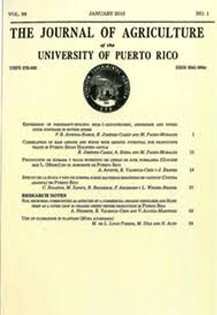Abstract
The effects of location (mid and high ground) and harvest period (beginning, peak and end) on coffee were analyzed in terms of the fruit's physiological state at harvest at the commercial coffee mills in Puerto Rico during 2009 and 2010. The effects on yield of the fruit's physiological stage and the damages caused by the coffee berry borer (Hypothenemus hampei Ferrari 1867) after the coffee was shelled, were also analyzed. Results indicate that between harvests there is a high fluctuation in terms of the proportion of ripe, partially ripe, green and over-ripe coffee that constitute the classification of ripe coffee bought by the coffee mill. The percentage of ripe coffee varied from 50% to 70% from year to year; these are very low percentages of ripe fruits for obtaining good quality and yield. The presence of green coffee at levels of 4.34% and 13.73% means a lower yield and deterioration of the coffee's quality. Thus additional effort and expense are required in order to separate the green beans that were bought as ripe. The yield of pulped and washed coffee fluctuated between 40% and 43%. From 2% to 3.5% of the coffee grains floated because of physiological causes not related to damages made by the coffee berry borer. Up to 3% of "caracolillo" coffee floats after being pulped and can be lost during the washing process. Average number of beans collected in the #14 sieve (smallest) and the #17 sieve were greater than the amount collected in the #19 sieve (largest). Results indicate that the percentage of "pergamino" coffee at 12% humidity fluctuates between 20% and 21% of the weight. These results show that coffee quality and yield are closely defined at harvest time. High amounts of ripe coffee berries and low quantities of green coffee beans are required in order to enter the coffee exportation market. The commercial coffee classified as ripe received at commercial coffee mills in Puerto Rico does not fulfill this requirement. Additional efforts must be made to improve the collection and selection of coffee at the processing level, especially if the goal is to obtain coffee with optimum exportation quality.Downloads
Download data is not yet available.

